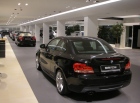Outshining the competition

To Russell Fletcher of Harvard Engineering, LEDs are no longer alternative lighting technology — and they boast impressive efficiency and life.
Maintaining a reliable and efficient lighting system is essential to running any medium- to large-scale business. In order to do so, many companies still rely on older technologies such as fluorescent tubes and incandescent bulbs, often with great success. The problem, however, is that compared to recent innovations, fluorescent and incandescent lights often make poor performers. Not only do they require replacing more often than their modern counterparts, they also consume far more energy than is necessary.
At present, the two most popular alternatives are CFL (compact fluorescent lamp) bulbs and LED (light-emitting diode) lamps.
CFLs are essentially a scaled-down version of a much larger fluorescent tube.
LED lamps are a larger array of light sources which used to be just found in small toys, Christmas lights, and similar electronic devices; however, new advances have made them perfect for more generic lighting.
Of these two interior-lighting systems, CFLs are probably the better known and have many converts. Nevertheless, it is important to assess their performance alongside both their newer and older rivals. Compared to incandescent bulbs, CFL tubes use 70 to 80% less mains power and last up to 10 times longer but are significantly less efficient than LEDs and have a shorter life.
 |
| Energy-efficient LED lighting for this BMW showroom in Rome has dimming capabilities that enable the cars themselves to be emphasised. |
If run correctly, LEDs last about 50 000 h — five times longer than a CFL bulb at 10 000 h.
Similarly, while a particular CFL might consume an impressively low 77 kWh a year, a comparable LED light might typically consumes 42.8 kWh a year — so the LED takes home the clear advantage.
As well as lower energy consumption and longevity, there are substantial environmental benefits to LED lights. Because LED light sources do not contain mercury, unlike fluorescent lamps, they are easy to dispose of and less likely to harm the ecosystem. Due to their overall design and incorporated heatsinks, LEDs also do not expend as much heat as other light sources.
In order for LEDs to operate, and also to ensure long-term efficiency, they require a further component to run. This is achieved through a device called a driver. By supplying the correct current and voltage required to the LED, the driver not only ensures the light source can run, but also that it neither overloads nor dims to insufficient levels.
At present, there are two basic types of driver — constant current and constant voltage. Deciding which version is right for the job depends on numerous factors — including the type of LEDs being installed, the number of LEDs being installed, and whether they will be placed individually or in series strings. However, it is the number of LEDs connected to a system that should determine which driver to use.
Where lights are run individually with one driver per light fitting, a constant-current driver would be employed. This ensures that luminosity remains constant.
Conversely, where LEDs are connected to one power supply, or when more might be added at a later time, a constant-voltage driver provides the best solution. With this driver, the current always increases to the system's maximum limit.
The benefit of utilising either driver, however, remains the same —supplying voltage and current to the LED, and always at optimum levels, so the LED can run at maximum efficiency. This means that, compared to incandescent or fluorescent lamps, the LED requires less frequent replacements — minimising environmental and financial strain at once.
 |
With LEDs and their drivers gaining an increasing reputation for energy efficiency, companies have already begun including them in their lighting upgrades. One of BMW's leading showrooms in Rome, for instance, has installed an LED lighting system that includes Harvard’s CoolLED CL standard class II driver. Since LEDs last an average of 100 000 hours, the installation is projected to last 11 years at continuous operation, or 22 years at half power — meaning the system will easily outlast the five years originally requested by the customer.
Due to the dimming capabilities of Harvard's CoolLED driver, BMW can run LED lights directly over the cars in the showroom at an illumination level of 800 to 900 lx, compared to the general showroom lighting of 600 lx. This capability creates extra emphasis on each car for maximum impact — increasing the appeal of each vehicle as well as reducing the energy bill.
Far from an afterthought, LED drivers are quickly becoming an essential component in large-scale lighting systems. Not only do they further reduce running costs and environmental damage, they help display what lies in their immediate vicinity, and always in the best possible light.
Russell Fletcher is sales and marketing director with Harvard Engineering.







